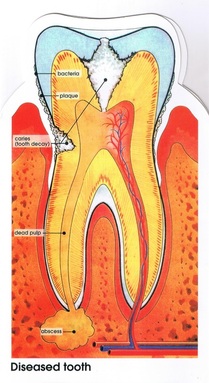Discoloured teeth – the causes
Discoloured teeth are a common phenomenon in Singapore. Due to high dental awareness, most of us brush our teeth at least twice a day and floss once daily. The colour of teeth can darken with age, while surface stains accumulate.
Depending on the criteria applied, almost the entire population can be considered to have discoloured teeth. Some people have individual teeth which turn very dark. Discoloured front teeth can bring about social awkwardness.
A much more commonly heard complaint is about teeth generally being 'too dark' or 'too yellow'. Why does this happen?
Depending on the criteria applied, almost the entire population can be considered to have discoloured teeth. Some people have individual teeth which turn very dark. Discoloured front teeth can bring about social awkwardness.
A much more commonly heard complaint is about teeth generally being 'too dark' or 'too yellow'. Why does this happen?
|
To understand what happens during a tooth discolouration, we need to know a bit about the structure of the tooth.
The visible part of our teeth is made up of 2 hard tissue layers – the enamel on the outside 1-3mm, and the dentine, which actually makes up the majority of the tooth structure. Enamel and dentine are made up of crystals called Hydroxylapatite and some collagen fibres. The crystals are shaped like rods, and are arranged in a pattern sort of like microscopic lego blocks. Enamel is mostly crystaline and slightly porous, but dentine has much more collagen and also has microscopic tube-like structures within it that are filled with fluid and some nerve endings. Right in the centre of the tooth is the pulp (more commonly referred to as the 'nerve', although it contains more than just nerve tissue.) |
For the purpose of understanding what is happening and what can be done, it is useful to distinguish between staining of teeth, which is something that happens to the outside of the tooth, and discolouration of tooth substance, which is a change in colour of the internal structure of the tooth itself. However, it is interesting to note that both phenomena are interrelated.
|
Different people's teeth do pick up stain at different rates. This is due to:
This sort of staining can be removed quite easily by brushing thoroughly (possibly using a whitening toothpaste) or having a professional cleaning (scaling and prophylaxis) done. |
|
Surface staining
When we drink coffee, tea, red wine or any other dark coloured beverage or eat foods containing intense dark-coloured substances, smoke or otherwise expose our teeth to dark coloured substances, these substances will probably stick to the surface of the teeth. Some rather distressing black staining can also be caused by certain types of bacteria which inhabit the mouth. All our mouths contain bacteria, and this is consistent with health. Certain types of bacteria produce coloured substances. The most common colour is a light yellow, but there are also some instances when black, brown or orange stains are produced. These stains can stick to the teeth even with good oral hygiene. |
|
Discolouration of the tooth structure
Discolouration of the tooth structure (dentine and enamel) is a much more deep seated phenomenon. To begin with, all our teeth have a natural yellow 'base colour'. This is because of the dentine which forms the bulk of the tooth structure. Individual teeth can be discoloured due to:
|
|
Stains/Discolourations between teeth
Many people ask me why there are dark patches in the spaces between their teeth. There are a number of possible causes: 1) Old filling material that changed colour While it is rare to see fillings done on front teeth using metallic material nowadays, some of the older tooth-coloured materials were not completely colour stable, and can darken over time. 2) Tooth decay The space between the teeth (interdental caries) is the most common site of major tooth decay. Practically everyone I meet brushes their teeth, but comparatively few people floss or otherwise clean between their teeth. This leads to plaque building up between the teeth and attacking the enamel. 3) Surface stains of enamel or filling materials The tooth surface or the surface of any filling material can catch stains just like any other part of the mouth, and this space is more difficult to clean. The space between teeth therefore accumulates stain. Special attention is required when brushing. |
General discolouration of teeth can be caused by:
- Drugs like Tetracycline taken when a person's teeth were forming. Tetracycline in particular produces a greyish stain, which can be very dark. The Tetracycline molecules get incorporated into the crystal structure of the dentine and enamel and react chemically with the calcium in them. This makes it extremely difficult to whiten these teeth.
- Fluoride. In many places (including Singapore) the water supply is fluoridated. This is a good thing, as it has been demonstrated to reduce incidences of tooth decay by 50%. Unfortunately, a very visible side effect (described as Fluorosis) is that the enamel and dentine become yellow, as a result of chemical reactions between the fluoride and calcium, which form a more decay resistant form of Hydroxylapatite called Fluoroapatite. This is part of the tooth crystal structure, and thus practically impossible to remove. As the severity of Fluorosis increases the teeth can exhibit yellow stains, white patches, brown patches and in extreme cases, enamel fails to form normally, leaving structural defects in the teeth. This condition is determined when the teeth form, and does not worsen with age.
- Absorption of dark substances from the surroundings. The same stain-causing substances that cause surface staining can also seep into the structure of the enamel and dentine, causing the teeth to tarnish.





